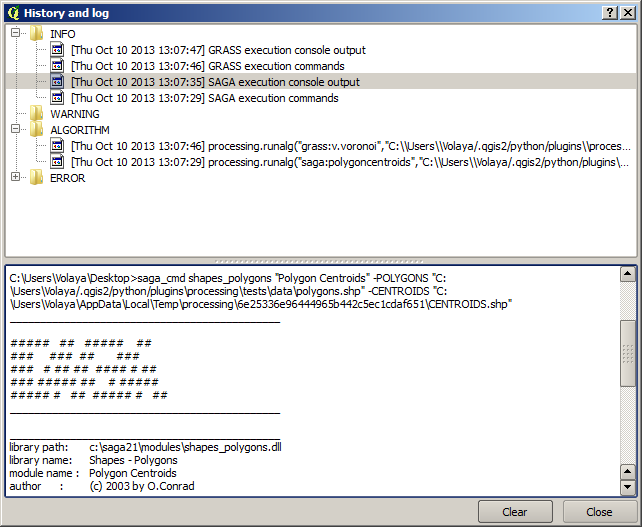履歴マネージャ¶
プロセッシングの履歴¶
いつでも履歴マネージャに格納されているプロセスの情報、アルゴリズムを実行できます.ここでは利用されたパラメータや実行された日時も保存されます.
この方法を使うとプロセッシングフレームワークを使って開発された作業の追跡と管理が簡単になり、再度開発することが簡易になります.
履歴マネージャは実行日時にしたがってグルーピングされたレジストリエントリのセットであり、任意の特定の時点で実行されるアルゴリズムの情報を見つけることを容易にします。
Figure Processing 30:
プロセス情報は、アルゴリズムをツールボックスから起動された場合でも、コマンドライン式として保持されます。ツールボックスを使用してアルゴリズムを呼び出し、それからヒストリーマネージャでコマンドラインから呼び出したアルゴリズムを確認するため、それはコマンドラインインタフェースを使い方を学習するのにも役立ちます。
Apart from browsing the entries in the registry, processes can be re-executed, simply double-clicking on the corresponding entry.
Along with algorithm executions, the processing framework communicates with the user using the other groups of the registry, namely Errors, Warnings and Information. In case something is not working properly, having a look at the Errors might help you to see what is happening. If you get in contact with a developer to report a bug or error, the information in that group will be very useful for him to find out what is going wrong.
When executing third party algorithms, this is usually done calling their command-line interfaces, which communicate with the user using the console. Although that console is not shown, a full dump of it is stored in the Information group each time you run one of those algorithms. If, for instance, you are having problems executing a SAGA algorithm, look for an entry name ‘SAGA execution console output’ to check all the messages generated by SAGA and try to find out where the problem is.
Some algorithms, even if they can produce a result with the given input data, might add comments or additional information to Warning block in case they detect potential problems from that data, in order to warn you about them. Make sure you check those messages in case you are having unexpected results.

